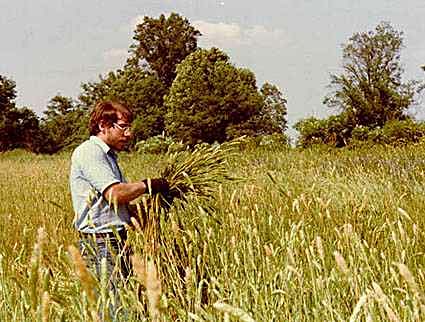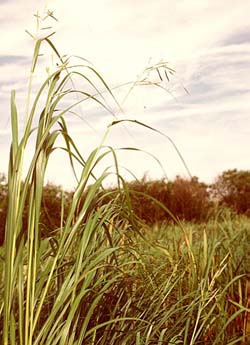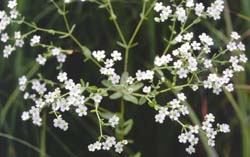
Wild Prairie Plants
After the four glacial advances of the Ice Ages, prairie developed and spread over 22 million acres of Illinois' land surface. The largest prairie region was the northern two-thirds of the state, but there were small prairies in southern Illinois, too. Prairie dominated the landscape so much in those areas that the only woods were groves of trees at the edges of the prairies. Early farmers used some of these plants to feed their livestock. Other plants had human uses as food or medicine.
Below is a list of some of the grassy and herbaceous prairie plants that grow on the Illinois prairie remnants today. Once they were widespread throughout the Illinois prairie.
Grasses:
Big Bluestem (Andropogon gerardii) is the official state grass of Illinois. It was the most abundant and tallest grass in the prairies that covered Illinois. The plant can form extensive turfs and is a major forage and hay grass. Its flowering stalk grows in three finger-like branches, giving rise to another common name of "turkey foot grass." It normally grows to a height of eight feet. The pioneers said it was as tall as a man on horseback. Deep roots help the big bluestem survive in times of drought. This plant was used by Native Americans, such as the Ojibwa tribe, to treat digestive problems.

Prairie cord-grass (Spartina pectinata) has a stout stem and grows up to ten feet tall, with leaves up to four feet long. This grass is commonly found in moist areas such as swales (shallow depressions) and wet prairie. It is very common in ditches and drainageways. Livestock do not readily eat prairie cord-grass except when nothing else is available in early spring. It contains low levels of crude protein and a fiber content of 40 per cent at maturity. It is used for hay today, and has been used for thatching and fuel.
Indian grass (Sorghastrum nutans) is an important tallgrass prairie plant because livestock eat it readily and it is nutritious. It is common to dry prairies, pastures, fields, and open savannas. The plant sports golden plume-like seed heads.
Canadian wild rye (Elymus Canadensis) provides good forage for livestock early in the season but is considered inferior forage upon maturity. Native Americans used the seeds for food.
Herbaceous Plants:
Rosinweed (Silphium integrifolium) is common to mesic (medium dry) deep soil prairies of the tallgrass region. It also occurs naturally in savannas, glades, and rocky or dry open woods. Native Americans used the plant to cure bladder problems and chewed the leaf to clean teeth.
Prairie blazing star (Liatris pycnostachya) occurs on glades, bald knobs, in meadows, dry uplands, and savannas. In traditional medicine, Liatris is used to induce sweating.
Early goldenrod (Solidago juncea) occurs in dry open fields and prairies.
Rattlesnake-master (Eryingium yuccifolium), also called button snake-root, grows well in difficult soils in dry climates. The name refers to its traditional use as a snake-bite remedy.
Culver's root (Veronicastrum virginicum) grows in open woodlands, thickets, meadows, and prairies. It is a tall plant with distinctive spikes of blue, white, or pink flowers. The roots have been powdered in traditional medicine for use to create vomiting.

Flowering spurge (Euphorbia corollata) is a slender-stemmed herbaceous plant that produces a milky sap that irritates human skin. It grows on dry, rocky prairies, in open woodlands, along roadsides, and in waste areas. (pictured right)
Cup-plant (Silphium perfoliatum) produces cheerful yellow daisy-like flowers on long, stout stalks reaching up to eight feet in height. It is locally frequent in moist areas along prairie streams, low thickets, floodplains, and along the edge of wet woodlands.
Gray-headed coneflower (Ratibida pinnata) is a tall, wispy coneflower with a drooping yellow flower and gray seed cone. It grows in dry woods, prairies, and along railroad tracks and roads.
Compass plant (Silphium laciniatum) get its common name fro the way that the leaves orient themselves in a north-south direction. Its towering eight-foot stalks bear big four to five inch flowers that resemble sunflowers. Native American children used the dried resinous sap of this species and related plants as chewing gum.
Ironweed (Veronia fasciculata) grows to three to five feet tall and has pink and purple flowers. The common name comes from the rusty color of the seed heads, but the plant is also very hardy.
There are hundreds of other prairie plants that grew on the Illinois prairie. You can still find some of them around today in remnant and restored
Find out more about Illinois prairie plants at our Illinois Prairie Online Module.







